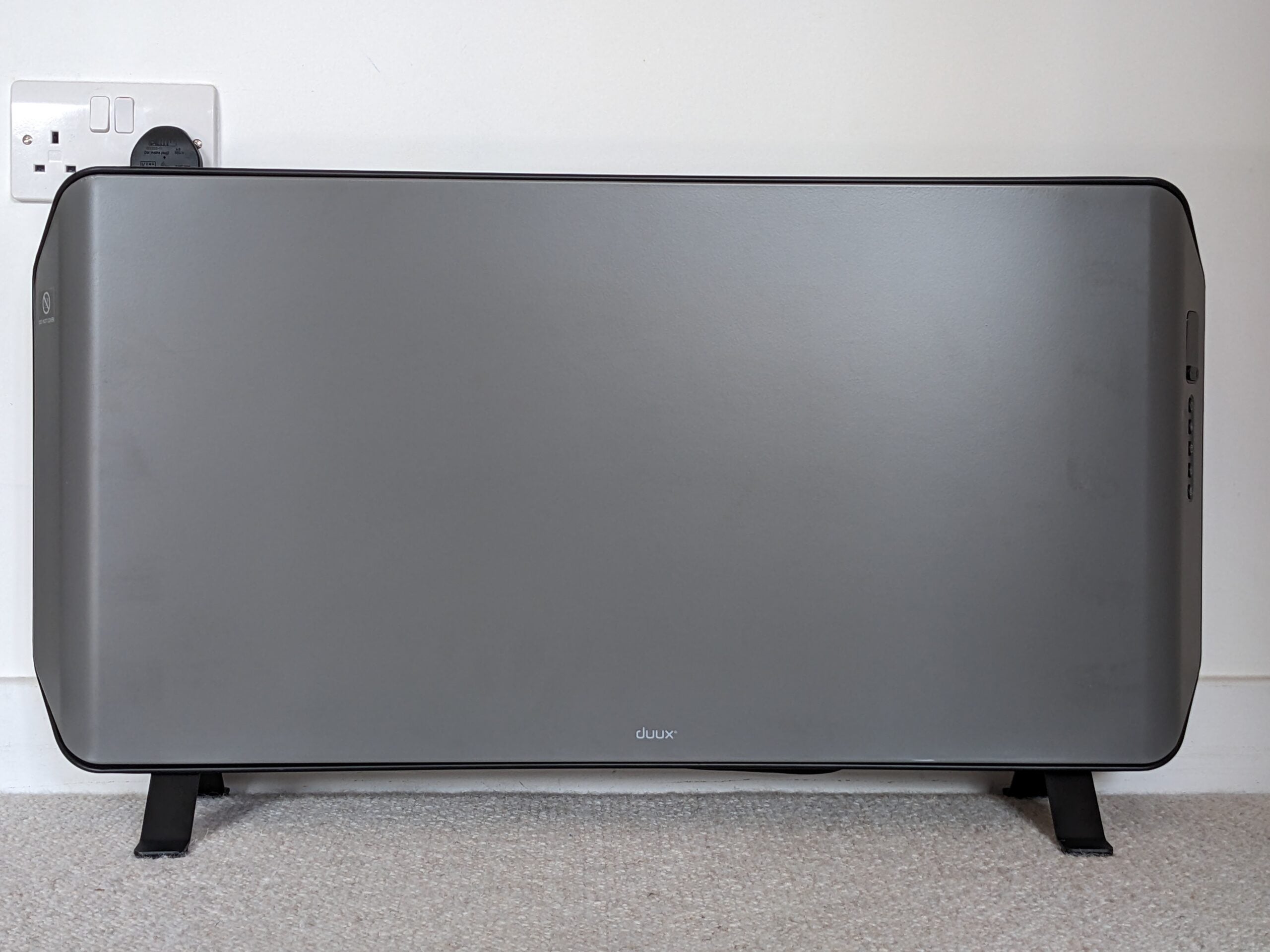Duux Edge 1000 Review
A smart heater, but not that powerful for the money

Verdict
The Duux Edge 1000 is much more appealing than most convector heaters, with a smart, vent-free facia that looks uncluttered and modern. It’s an effective device, producing enough heat for medium-sized, well-insulated rooms, and it’s easy to use thanks to a remote control and Duux’s decent smart app. It is a touch expensive for its output, however, and will cost more to run than an infrared heater.
Pros
- Looks clean and modern
- Good controls and remote
- Smart features available through app
Cons
- A touch expensive to buy
- Could be expensive to run
Key Features
- An attractive convector heaterThis 1,000 watt fanless heater has the power to heat up small or medium rooms, so long as they’re well insulated.
- Smart controlsDuux’s app lets you create schedules or control the heater with your voice – it’s easier to use than the standard controls or remote
Introduction
The Duux Edge 1000 is one of the Dutch manufacturer’s small range of convector heaters. They’re available with the one kilowatt (kW) output tested here, or with 1.5kW or 2kW, and can be had in white or dark grey. All the models have quite sophisticated controls, duplicated on a supplied infrared remote, but they’re also smart: working with the Duux app to make it much easier to use more advanced features.
Convector heaters are often boring looking, flimsy devices, so the Edge 1000 immediately stands out. Its un-vented and uncluttered front panel is modern and classy enough for any setting. It also feels like a step up in quality when compared to cheaper convectors – the panels are thick enough that they don’t ring out whenever you tap them. While this heater’s white finish doesn’t look quite as modern as the grey Duux Edge 1500 reviewed last year, it’s still classy, and less ‘of the moment’, so it’s perhaps less likely to go out of date.
Design and Features
- Lovely modern design
- Excellent smart features
- Remote and app control
The Duux Edge 1000 looks almost like a blank panel, thanks to the angled edges that tend to conceal the controls set into its right hand side. These comprise a small LED screen with buttons to manage power, temperature, schedules, an off timer, and the night mode.
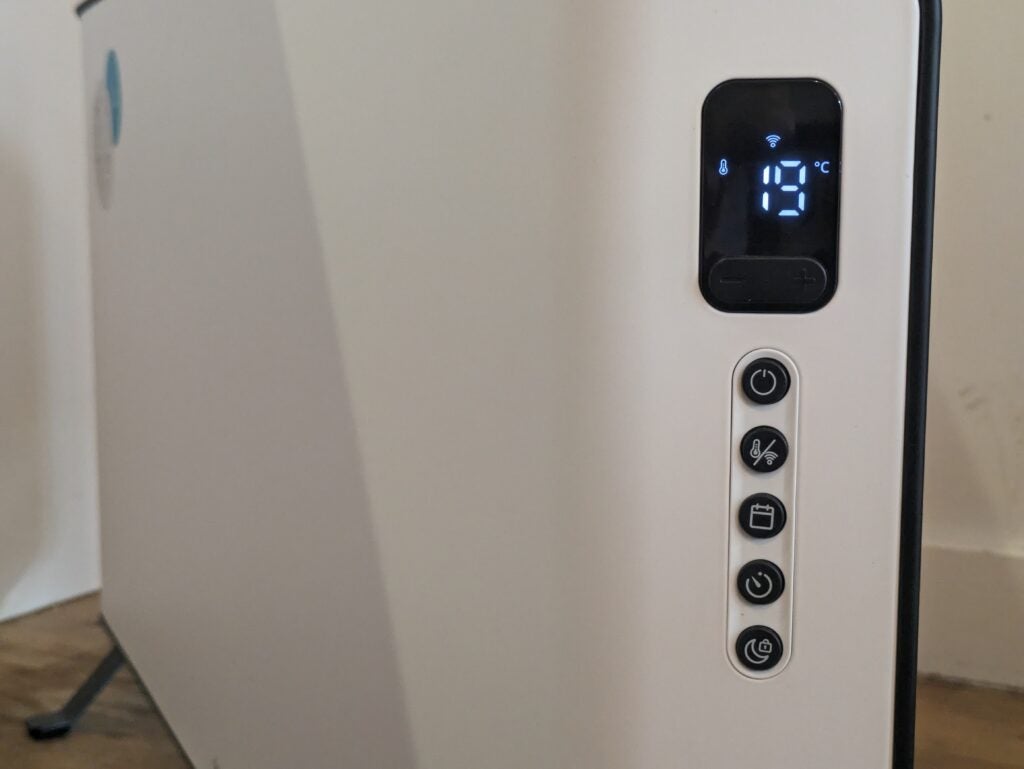
They’re all duplicated on the infrared remote control you also get in the box. It’s a measure of Duux’s attention to detail that on white models this is white, whereas it’s grey on the grey ones.
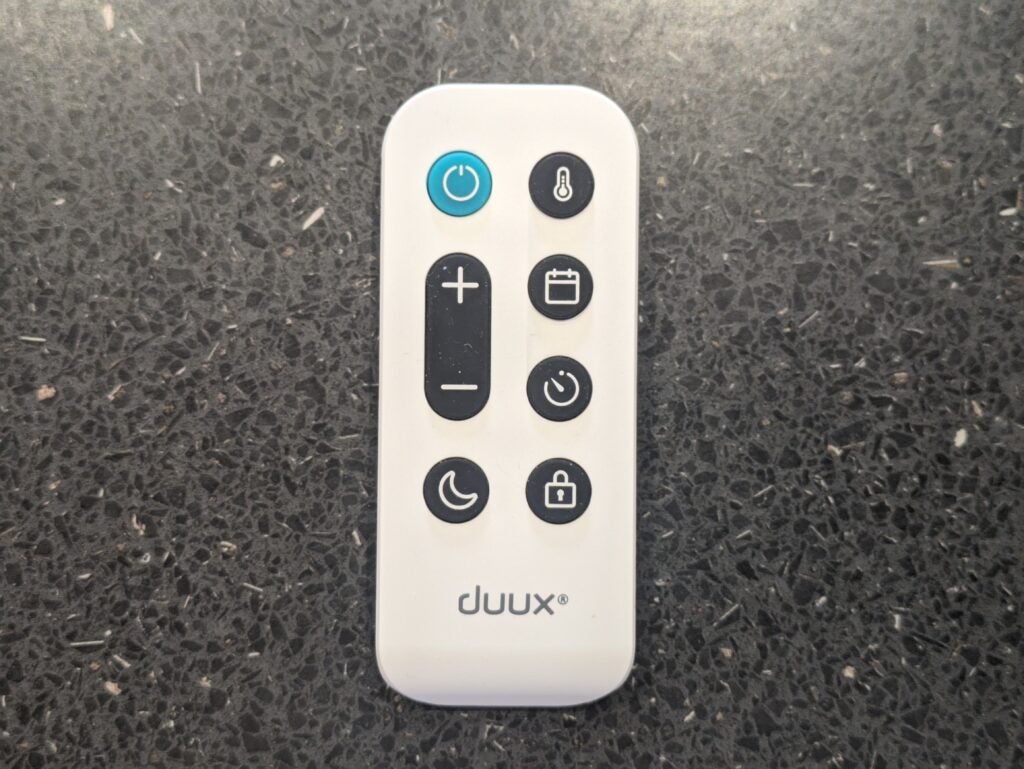
This heater comes with wall mounting brackets and a set of metal legs, the feet of which are covered with felt pads to stop them scratching wood floors. Surprisingly, perhaps, the Edge 1000 is no smaller than the more powerful models in the range. Still, at only seven centimetres deep it won’t stick out too much if you wall-mount it, and its 80cm width would be easy to accommodate in most rooms. This isn’t a heavy heater, but with no handle it’s not the easiest to move around – especially not when it’s still hot.
While you can operate the Edge 1000 fully with its onboard controls, things begin to get complex once you delve into its partially preconfigured schedules. It’s much easier to just install the app, which offers the same features as the remote and control panel, but makes scheduling a breeze. You can also integrate it with the Google Assistant or Alexa, and control the heater with your voice.
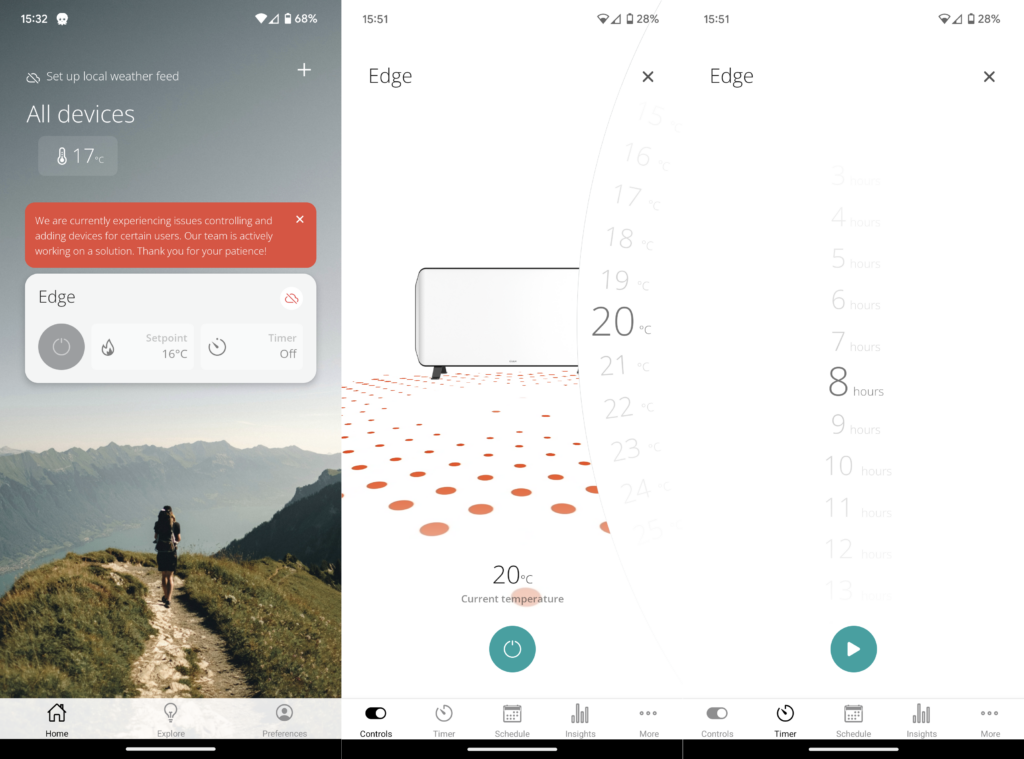
Unfortunately, Duux’s second-generation app still isn’t perfect, almost a year on from when I previously had problems with it. I was at first unable to add the Edge 1000 at all, later receiving a notification that the system had temporary problems. After subsequently getting everything up and running, I decided to sign in (which is optional), after which the heater disappeared from the app and I had to add it again.
It’s a shame that the app may not give a great first impression, because it’s fine once you’ve set it up properly. I particularly like the way you can create and drag a schedule to the times and days you want, as in the left-hand image below.

With no fan, this is a near-silent heater: the only sound you’ll hear is the click of a control relay as it cycles on and off to maintain the set temperature. The Edge 1000 does beep when you use its remote or control panel, but you can stop this by selecting Night Mode.
This heater features open window detection, switching itself off to conserve energy if the room temperature suddenly drops by 5°C. That’s quite a high bar, though: on still, cool days you could easily have a window open without losing that much heat. The Edge 1000 also has a child lock to prevent urchins playing with its controls. Its case does get hot in use, so you shouldn’t leave younger children unsupervised when it’s running anyway.
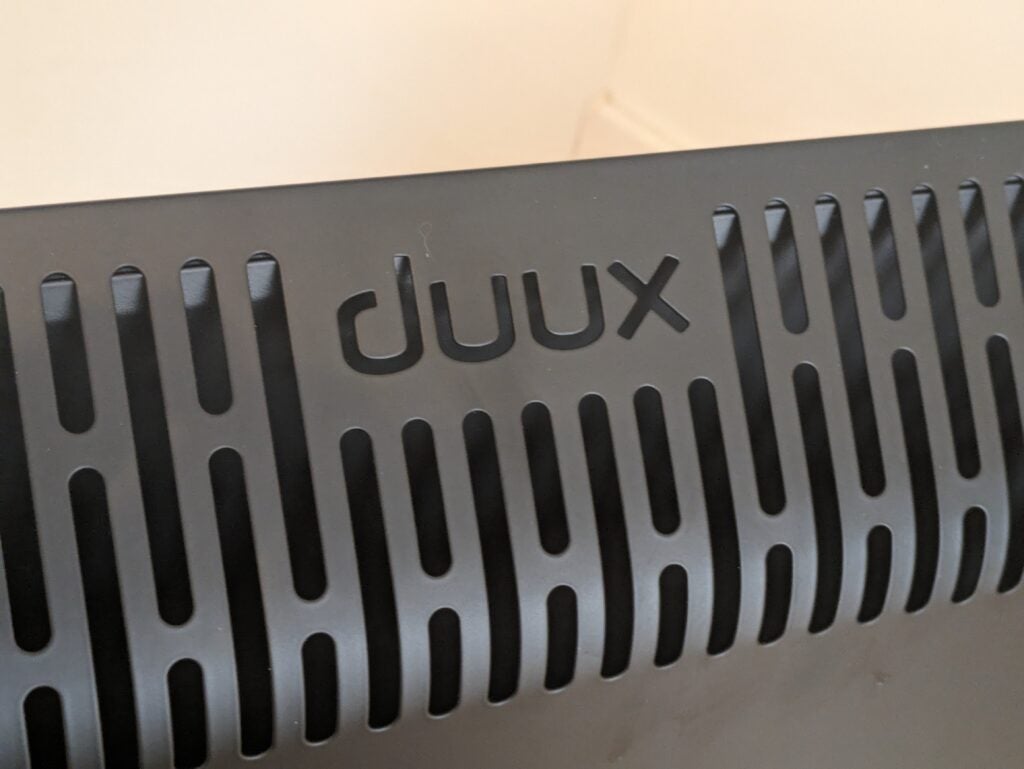
Performance
- Fairly effective
- Could be expensive to run
With only a 1kW rating, you shouldn’t expect the Edge 1000 to heat larger rooms, or even heat a small one especially rapidly. I tested it on a freezing January day, in a medium-sized bedroom that had been allowed to cool to 16°C overnight. After 30 minutes the Edge 1000 had got this up to 17.3°C, and after an hour it had hit 18.3°C. That’s a respectable performance, and certainly enough to maintain a decent temperature, but this heater probably isn’t ideal for the times when you want to warm things up more quickly – you might want to consider a higher powered alternative for that.
As you’d probably expect for a 1kW device, the Edge 1000 consumes about 1 kilowatt hour (kWh) of electricity each hour – I measured 1.063kWh during the above test. However, it’s important to understand that heaters cycle on and off once the room reaches the target temperature. Their actual consumption will depend on how hot you’re trying to get, how large the room is, and how well it’s insulated.
In my well-insulated test room I’d expect the Edge 1000 to use around 50-70% of the above figure each hour once the room was up to temperature on a cold day. At the January 2024 price cap of 29p per kWh, that means I’d pay 29p an hour while the room was warming up, and perhaps 15-20p each hour to keep it warm.
With no core to speak of, the Edge 1000 is quick to warm up, but it doesn’t continue to release much heat after it’s been switched off. I measured a peak of 18.5°C 15 minutes after unplugging it, a further 0.2°C increase. On the one hand, this means it’s less likely to overshoot your selected temperature, but on the other hand it can make for a slightly on/off feel to the way it heats.
Latest deals
Should you buy it?
A great-looking heater
The Edge 1000 is generally easy to use, and is effective in smaller rooms. Best of all, it’s good looking enough to hang on the wall, which isn’t something we’d say for most heaters.
Could be expensive to run
This is a comparatively expensive heater and, like other convectors, it could generate large electricity bills if you need to rely on it in cold weather.
Final Thoughts
The Duux Edge 1000 could be a good way to heat a smaller room. It looks great, is quite easy to use, and its smart controls give you a lot of flexibility when it comes to scheduling. It is quite expensive – a basic convector heater comes in at about £40 – but it does feel like a premium product.
This heater doesn’t really have any weaknesses, but like other connectors, it could prove expensive to run – particularly if it’s the sole source of heat for a room. That might not be an issue if you’ve got access to cheap electricity from solar panels or the like, but otherwise it’s worth considering an infrared panel heater instead or something else from the list of best electric heaters.
FAQs
They certainly can do, particularly those with a rating of 2,000 or 3,000 watts. The Edge 1000 uses a maximum of one kilowatt hour (kWh) every hour, equivalent to 29p under the January 2024 price cap. It’ll use less than that in a small, well insulated room, particularly when it’s just maintaining the current temperature.
Aside from potentially being expensive to run, convector heaters don’t typically warm a room up as quickly as a fan heater. On the plus side, they’re usually silent or nearly silent, so they can be easier to live with.






